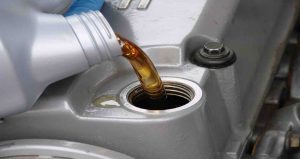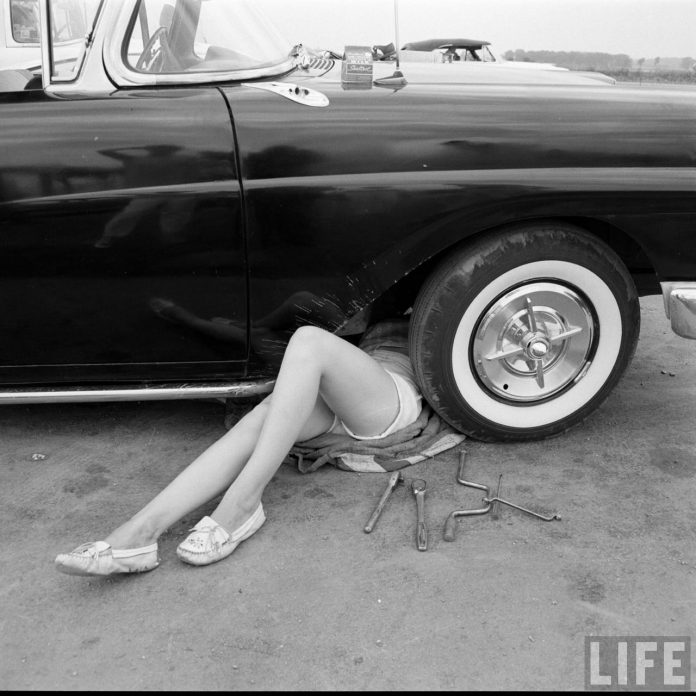Knowing when it’s time to change the oil in a regularly driven car is easy – the car’s manufacturer provides specific time and mileage intervals. They are right there in your owner’s manual. In addition to this, many cars built since the early 2000s have built-in oil life/condition monitors that fine-tune these intervals by chemically sampling the condition of the oil as you drive, advising you to change it sooner – or later – according to its actual state, which is a function of the type of driving you do.
But what about a car that isn’t driven much? One that passes by the maximum originally specified time interval without having racked up even a fourth of the specified miles?
Does it makes sense – is it necessary – to change the oil (and filter) if the car has only been driven 500 miles since its last oil change just because it’s been a year since its last oil change?
It is ok to leave it in there until it reaches the mileage interval, even if takes two years to get there?
Probably not.
To understand why the first thing to know is that it’s not so much the oil you’re changing as the contaminants in the oil you’re draining and getting rid of. These include water – which gets into the oil via both internal condensation and also from the ethanol that dilutes most of the gas sold in the United States. Ethanol attracts water and ethanol (alcohol) is also corrosive.
Gasoline itself is another source of contamination. It’s a solvent as well as a fuel and very good at leaking past old, brittle o-rings and gaskets and other fuel system parts and seeping into places where it’s not desirable, such as the crankcase (the bottom part of the engine, where the oil sits when the engine isn’t running).
Cars made before the early ’80s that have carburetors rather than fuel injection are especially prone to gas getting into the oil – and not just from seeping while sitting. Carburetor-fed cars sometimes run rich (more fuel than ideal in the air-fuel mix) and that problem is double-downed on if the car is only started and run every once in awhile.
it might seem counterintuitive, but the longer a car just sits, the faster the oil acquires things you don’t want in the oil.
This happens in part because of the nature of sitting idle (seals and o-rings dry out andshrink faster when they’re not bathed in circulating/pressurized fluids) and also because a rarely or lightly used car may never run long enough for the engine to get hot enough burn them off.
The worst case scenario – from the standpoint of unwanted shortening of the life of the oil – is the occasional start ‘em up and let it idle for a few minutes in the garage – and then shut it off. Some people think that firing up their old car once a month or so and letting it idle is good policy.
In fact, they’d have done the car a favor to leave it under the cover.
If you start the car, always try to drive it. For at least 15-20 minutes and not just around the neighborhood. Try to take it on a road where you can get it up to at least 50 MPH – in order to get the engine running at more than a fast idle speed.
This will get it to normal operating temperature. The engine, transmission – everything. And that will bring the oil to normal operating temperature – which will help burn off most of the stuff you don’t want in the oil.
The oil itself won’t ever wear out, incidentally. It can be recycled indefinitely. But the crap held in suspension in the oil has got to be gotten rid of – which is why you change the oil. And there’s another reason: The additive package mixed with the oil at the time it was formulated does dissipate over time. When you change the oil you refresh the additive package as well as the oil.
Ok, with that backgrounder in mind, when should you change the oil (and filter) in a car that isn’t driven enough to reach the mileage interval originally specified – or which reaches the time interval long before the specified mileage is reached?
A good rule of thumb is once a year, regardless. Try to do it before the period of least use – such as in fall for a car that will probably sit idle for most of the winter. This will remove the gunk that would otherwise sit inside the engine and also coat the engine’s internals with fresh, uncontaminated oil – protecting wear surfaces such as cylinder walls, bearings and so on.
You could extend that another six months or even another year – and some might argue it makes sense to do so given the cost of oil. My counter is that oil is a lot less expensive than engine problems and changing oil is a lot less hassle than engine problems.
Also, it’s not just engine oil that should be on your change radar.
Engine coolant should be drained and replaced every three years, regardless of mileage, to avoid a gunked-up radiator and overheating problems. It’s also a good idea to replace the brake system’s fluid at this time, too. If you regularly take a look at the brake system’s fluid reservoir you can watch it transition from translucent/honey-colored to dark brown to black (very bad) over time. Change it before it goes from dark brown to black to avoid expensive brake system problems. 
And don’t forget to check the air filter. It probably won’t be dirty if you don’t drive the car much and being paper, it can last for years. But you might discover that a mouse or squirrel has made himself a nest inside the air cleaner housing. You’ll want to clean out the shredded newspaper and nutshells before you fire up the engine.
. . .
Got a question about cars – or anything else? Click on the “ask Eric” link and send ’em in!
If you like what you’ve found here, please consider supporting EPautos.
We depend on you to keep the wheels turning!
Our donate button is here.
If you prefer not to use PayPal, our mailing address is:
EPautos
721 Hummingbird Lane SE
Copper Hill, VA 24079
PS: EPautos magnets are free to those who send in $20 or more. My latest eBook is also available for your favorite price – free! Click here. If you find it useful, consider contributing a couple of bucks! 












Engine oil acts as a lubricant and lubricates different moving parts of the engine. But with the flow of time it becomes degraded and degraded oil can’t do it’s function properly. Therefore it is necessary to replace engine oil with suitable at suitable time .Thanks for sharing such informative article.
Eric I am surprised you still parade that ancient old saw about seals getting dried out and cracked.. with modern seal lip materials, they remain supple and functional for decades no matter what is done/not done to them. I’ve torn down engines and gearboxes with hundreds of thousands of miles on them and the “rubber” seals inside look and feel brand new. I could detect NO difference between the old ones and the new ones with the parts kit.
I’ve also got new in box seals I purchased forty years ago, never used, and they are also as supple and soft as a new one bought last week. You must be stil stuck on the old hide, woven packing material, wax “lubricant” type dog-doo seals from the 1950’s and earlier.
Your remark about NOT letting the old beauty sit and idle for half an hour once a month is golden. Surest way to cut the service life of an engine in half or less I know of. Better to let it sit. Then, once started, take it out and RUN IT. Warm it up gently, then work it hard.
On antifreeze, with today’s engines comprising many different metals, the biggest danger with not changing the antifreeze regulalry is electrolysis. Per Galvan’s law any time there are two different metals in contact with the same liquid, if that liquid has any loose ions in it, one metal WILL dissolve into the liquied and deposit itself on the other. Multiple metals, a pecking order results…. I have worked with this principle and problem in the marine environment for years. In modern car engings with dozens of different metals, eventually the coolant develops inionic charge, and the metals begin to dance….. aluminium is usually one of the first to sacrifice itself. I’ve seen huge pits, caves, even bit holds, eten out of aluminium when the coolant has gone active. Many of those bits are very dear to replace. I’ve seen a hole clean through the aluminium timing cover leaking coolant into the crankcase. Owner was convinced he’d blown a head gasket, so replaced them. Problem remained. Friend had a nice Peugeot diesel wagon that used coolant at a pretty high rate. Asked me to replace the head gasket. I insisted on milling the head surface, he protested bt relented. We did. STILL used water. I applied a pressure tester and umped it up.. pressure dropped at a nitoceable rate. Could NOT find any leak.. then I started it again and an YUGE cloud of steam poured out the tailpipe. Hmmm….. removed the exhaust manifold and applied perssure again… number three exhaust port had a leak.. galvanic corrosion had eateh through the water jacket, dumping the coolant into the port, then into the manifold and exhaust ssystem. I was able to repair the leak with head in place. Told him to mind the conditioin of the coolant going forward. THAT was a job that required the old gumshoes and spyglass. He ran it for some years after that no trouble. Nice car, actually.
Tio, I recently replaced the original brass radiator in my ’68 F250 with an all aluminum radiator, and went to HOAT coolant to try to guard against that electrolyisis problem you described. I’m having the old radiator recored as soon as I can, but I wonder how long the coolant will last before it needs to be replaced.
I’ve taken to measuring the coolant’s protection from corrosion with a multimeter.
https://www.familyhandyman.com/automotive/car-maintenance/coolant-testing-with-a-multimeter/view-all/
BrentP,
Thanks for link. Will need to look at my Radiator soon.
If a car is going to be STORED, you might give consideration to put Sta-Bil in the gas tank, pulling the plugs and pouring in STP or LucasOil and crank the engine (coil wire pulled) a few times. Re-insert the plugs finger tight but don’t reconnect the ignition system. Put the thing on stands to keep the tires from becoming ‘out of round’.
On my 2014 Ford Focus, I change according to mileage, but go IAW the ‘average’ that Ford recommends, which is 7500 miles. Coincidentally, that’s right about six months, which is what I’m comfortable as a maximum interval regardless of mileage. I can see where a one year interval would be alright with a vehicle that is taken out very infrequently.
IMO, a car is a bit like a thoroughbred horse…even the animal with the finest lines can be rendered ill and useless if it just stays in the corral and/or barn…the animal is meant to be ‘exercised’! It’s no different for the ‘iron horse’…’Baby’ needs to get out on the road and put through her paces! (and it’s a good thing to take the car out for a drive too!)
Eric,
Whatever are your thoughts on a hybrid driven 50,000 miles a year. I use my 2010 Prius mostly for ride share, use Mobil 1 0/20, the stuff for high mileage cars, and I recently passed 200,000 miles on the clock. Car runs great, but it does use a lot of oil, half a quart every other day. I change the oil every 10,000 miles.
I’ve had squirrels destroy in cabin air filters (somehow) by storing their acorn stash in there. Pulled it out, 1 lb of acorns went spilling into the AC fan compartment that I had to disassemble to clean out. Damn tree rats.
Mice do that around here, stashing acorns in the cabin filter box and in the air intake box. The engine air filter’s steel grid gave me an idea, and so I cut out a piece of one I was changing out and fitted it into the intake opening behind the grille. That worked for the engine air intake, but I haven’t figured out how to protect the cabin filter box yet.
The oil monitors in passenger cars do not chemically sample the oil. Most are a timer for engine run time, or mileage that can be programmed. Some newer ones will adjust for type of driving. Chemically sampling the oil required equipment far more sophisticated than what’s in cars. Love your articles, but this should have been better researched.
Oil does go bad & cannot be recycled indefinitely since it becomes acidic from combustion byproducts.
Acidity cannot be filtered out.
A&P/IA,ASE
Is re-refining more than filtering? Does not that bring the oil back to its proper condition? What is your source or personal expertise for that information? Just asking, not challenging, not an expert myself, but always told that re-refined product was “as new”. Even as a kid, I avoided it and paid for the “new stuff”, but that was the line at the time and seems to be still.
Dave – the re-refining process removes the acids by ordinary distillation. The product is usually tested to ensure that it’s fit for use. Of course, the additives necessary to make it “API Service Class SN” or equivalent have to be added to the base stock, so it’s not true that the ENTIRE recycled oil is ‘reused’. It’s the base stock that typically can be reused.
Once a year for oil is fine, even with a car that is driven only a few thousand miles a year, like my Trans Am.
The common theory is that Dino juice (Oil) has been around for many thousands of years (un- “refined”) and will be fine.
The truth is that the additives, which depend heavily on when the oil you have in your garage, thanks to various governmental fatwas (I’m borrowing the term), have a big time effect on how long the oil is actually good for.
As Eric states, it’s cheaper to just change the oil. I do it once a year with no issues.
Definitely drive it, but if that isn’t practical as it isn’t here in the Northeast a lot the time, give it an hour of idle time.
The transmission will be heated sufficiently to circulate its fluid.
But make sure the rear differential is looked after as well as the brake fluid. There are visual and even chemical tests to verify the condition of these fluids.
For what it’s worth, and I’m nothing more than a backyard mechanic, I’d only rely on the dashboard recommendations of a daily driver, not something that is mostly parked.
Most of the newer cars rely on an algorithm that considers run time and other factors to let you know when it’s “time” to change the engine oil. I may be missing something with newer vehicles, but at least in my fleet there isn’t any actual chemical test done by the multiple computers, it’s just an estimate based on usage, nothing more.
Excellent article as always, Eric, I’m just throwing in my .02.
We change the oil in our “newer” (2006!) at about 50% on the oil life display. That averages about 6K miles which seems like a lot but it is mostly highway driving since we never drive it unless we are going to town (minimum 50 or 120 miles round trip) or out of state. Never drive it locally except to get out to the paved highway 10 miles away.
It’s over 60 miles from our house to the nearest stoplight!
My wife has a 2013 Honda with the oil life monitor. Not sure how it works, but I don’t trust that thing at all. We bought the car new, and the owners manual said not to do first oil change until the monitor says to. Well, after about 10 thousand miles, it still said 60% oil life. I said, screw that, and changed it anyway. Ever since, I do it between 4 and 5 thousand miles. Monitor usually reads somewhere between 70 and 80 percent at that point. Sorry, Honda, that’s too long for me.
Thanks, Jim!
What year is your TA, by the way? Mine’s a ’76 – in Carousel Red with the Honeycomb wheels!
Hi Eric,
I have a few Pontiacs- two are Trans Ams- one is an 85 (first car I bought with my own money) and the other is a 95 convertible.
I’d love to have a 2nd gen and have looked around at them but at this point in my life I don’t have the time to repair/ restore an affordable one and don’t have the money to buy one nicer than that.
Someday!
Hi Jim,
Good stuff!
I love the third gen cars – would love to have a circa ’85 as well, with the L69 HO 395/4 barrel (last before injection) and the five-speed… have driven a few of these and while not brutally fast, they are a lot of fun… like my ’76!
I think 3 years is too long for brake fluid. Especially under the present operating conditions of most vehicles. 2 years is better.
Can’t really afford to change the oil every year on a vehicle that has had less than a tank of gas run through it in that time. I do try to start and warm it up thoroughly ever couple months or so.
Thanks so much for this article! Been reading your stuff since before driver’s ed and I follow you now via RSS.
Telling even seasoned mechanics I go a year or more between oil changes sends me to the nut house. I’ve never seen a definitive discussion about _time_ interval changing until now.
Being a motor head and doing my own changes since the “Mobil 1 will destroy your engine” days, I’m already familiar with the bullet points you present, especially about getting the engine to normal operating temperature.
When I retired over a decade ago, my mileage dropped to less than 1000 a year on my 2003 4.3 auto S-10 now with 42k on the odo. The last three years I’ve averaged 700 miles that get wrapped up during up my 3-4 times a month I’m out running errands and shopping.
To that end I had an email discussion with a Mobil engineer around 2006 where he allowed I could go two years with their Extended Performance and a high quality filter. For me, the latter is the Purolator PureOne, in my S-10 the longer 4WD part.
And two years strictly because my vehicle is garaged, driven occasionally, consistently and I live in the Southwest where humidity rarely exceeds 10%. One year, 18 months max, if I want to use less expensive products.
So, as my health ran down, I went from doing my own changes to finding a shop that would do it using my Mobil 1 and Purolator.
Now as my budget has become much tighter, every year I now scout for and find a $25 coupon for a franchise repair shop oil-change special with a “brand name” synthetic blend and premium filter, Penzoil and Fram as of the latest. I insist I examine the barrel and filter. Local car dealers have similar deals, but I can’t do that or watch the work get done.
One more point: fuel conditioner. I use Sta-Bil 360 Marine.
I’m planning on getting buried in my S-10. Cheers.
Yeah, the fuel stabilizer is a must for my old ’68 F250 Ranger CS. I went to synthetic oil and Lucas oil stabilizer because the truck only gets driven about 7 miles a week these days. Recently I switched from Sta-bil to Royal Purple fuel treatment. The fuel stabilizer is important indeed.